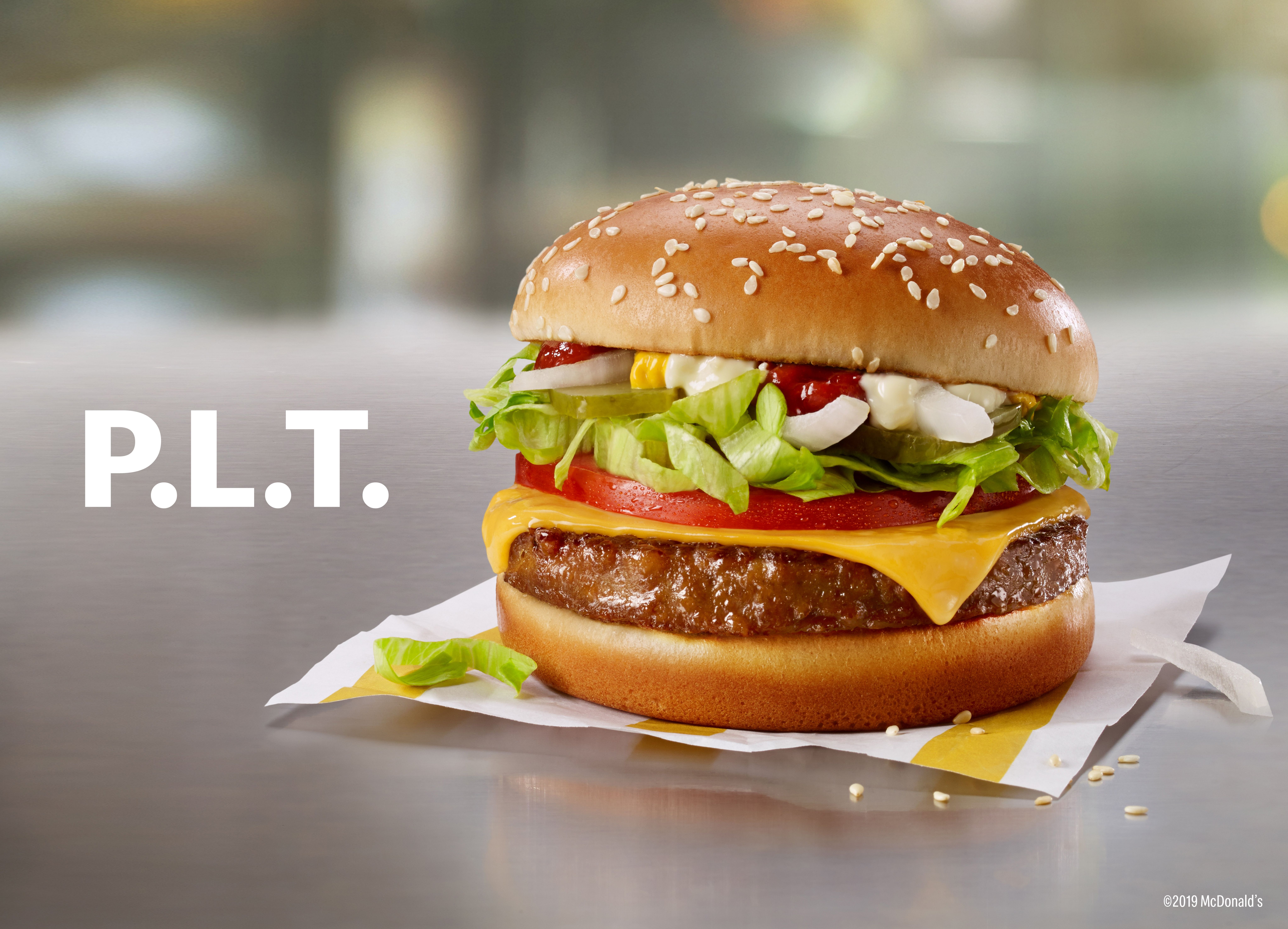Meat alternatives technology: Getting better every day
Plant-based ingredients are transforming the meat-analogue category.
McDonald’s new P.L.T.—a.k.a. “Plant”—debuted at select locations in September. McDonald’s describes it as “made with a juicy, plant-based patty made with Beyond Meat and served on a sesame seed bun with tomato, lettuce, pickles, onions, mayo-style sauce, ketchup, mustard, and a slice of processed cheddar cheese.”

How do you know when a food trend is worth taking seriously? When McDonald’s picks it up.
And by that measure, plant-based meat alternatives are some serious business. In late September, the fast-food chain that put burgers on the map began a 12-week Canadian test run of the P.L.T.-a.k.a. “Plant”-a meatless patty that Beyond Meat, the Los Angeles–based purveyor of plant-protein products, developed expressly for McDonald’s.1
This came less than half a year after Beyond Meat raised almost a quarter of a billion dollars in a high-profile initial public offering.2 And it came within a week of the September retail debut of the Impossible Burger, the contribution of Impossible Foods (Oakland, CA)-now joining competitor Beyond Meat in the grocery store aisle-to the burgeoning meatless-burger bonanaza.3
Yet these are just the most conspicuous examples of how plant-based innovators are disrupting the very definition of what we call “meat.” And as far as Steven Gumeny, regional product manager, North America, Beneo (Morris Plains, NJ), is concerned, the best is yet to come.
“The recent IPO from Beyond Meat and the growth of the Impossible Burger were certainly breakthroughs showing just how strong demand for plant-based meat alternatives is,” he says. “It’s exciting to see two startups become clear market leaders almost overnight. And now major food brands are buying in, trying to innovate quickly to catch up.”
Their innovation wouldn’t be feasible, though, were it not for an emerging class of plant-based ingredients that approach the taste, texture, appearance-even the nutritional value-of “real” meat. In so doing, they’re leaving the bean burgers and tofu patties of the past in the past.
Meeting the Meat-Free Need
You needn’t be a vegetarian-let alone a vegan-to appreciate the latest generation of cheat meats. In fact, the 2019 International Food Information Council Foundation’s Food Health Survey found that one-third of consumers eat plant-based protein daily, with three quarters viewing protein from plant sources as healthy.4
Cargill (Minneapolis) conducted its own survey of consumers’ protein perceptions and found that of the 1,900 U.S. grocery shoppers polled, nearly half agree to feeling better about eating plant protein, and almost as many actively try to eat more protein from plants,5 notes Pam Stauffer, Cargill’s global marketing programs manager.
And though consumers across the age range are curious about plant-based meat alternatives, the real oomph comes from the younger crowd. ADM’s (Chicago) OutsideVoice Primary Research Study, completed in May 2019, found that younger consumers “drive the plant protein agenda,” says Kurt Long, ADM’s commercial director of protein specialties and flexitarian solutions, “motivated by health and wellness, taste, ethics and beliefs, and cost and convenience.”
If It Tastes Like Chicken…
Young or old, plant-curious consumers have triggered an explosion in product development. “New launches have grown significantly,” Stauffer says, “and with these innovations we’ve seen dramatic improvements in product flavor and texture. Those who may have been turned off by early versions of meat and dairy alternatives are coming to them today and finding a different, very satisfying experience.”
For that they can thank novel plant-protein ingredients that are closing in on the organoleptic qualities of “real” meat. While past iterations of meat analogues mainly replicated ground proteins-think burgers, patties, sausage crumbles, and franks-current products can aim much higher.
As Melissa Machen, senior technical services specialist in plant protein at Cargill, explains, “Burgers were always a forgiving format for meat analogues, as they’re usually served on a bun with condiments and other toppings that add flavor, texture, and juiciness.”
But with new ingredients surfacing, “We’re seeing other product formats that closely mimic traditional meat in color, texture, and bite, including meatless nuggets, analogue tuna, and plant-based meat alternatives in frozen and convenience foods,” she continues. “It’s clear that some brands are striving to create products that are indistinguishable from meat-a goal they’re making significant progress toward accomplishing.”
Long adds that by altering inbound ingredients and extrusion methods, his team “can yield a variety of different shapes, sizes, and textures depending on the target application.” Even pulled pork is possible, he claims.
“Some products, like fish analogues, may require a completely different ingredient set and processing method,” Long continues. “But by having a deep understanding of the science behind the ingredients that go into these products, we can design natural flavors and maskers to make these products emulate meat even better.”
Go-To Ingredients
As for which plant proteins create the best meat analogues, “function, cost, sustainability, availability, flavor, and nutritional characteristics are all qualities we consider,” Long says. “There’s no one protein that’ll check every box for every consumer, but in combination, you can complement nutritional and taste profiles.”
Soy still dominates, “and for good reasons,” says Mark Cornthwaite, industry and marketing manager, DuPont Nutrition & Biosciences (New Century, KS). “Soy is the most nutritious, functional, and highly available protein on the market-although that supply is highly constrained. More than 40 years of science are behind it, from the early days of a highly flavored basic protein to today’s highly palatable protein that can bind, hold moisture for juiciness, and reduce dehydration.”
Hot on soy’s heels-and getting hotter-is pea protein. In both powdered and textured form, “Pea protein delivers quality protein and functional performance similar to soy,” Machen says. “Our Puris textured pea protein delivers a neutral flavor profile and high protein content for an array of meat-alternative applications.” Cargill began a joint venture with pea protein, pea starch, and pea fiber supplier Puris (Minneapolis) last year. Most recently, Cargill invested an additional $75 million to help Puris more than double its pea protein production.
Looking beyond pea and soy, ADM’s Long points to chickpeas, pulses, seeds, and ancient grains as “a few more of the ingredients we’re currently working with in formulation.” His team is even exploring options like lupin, algae, and mycoprotein.
“We also expect new sources in the future like sunflower, linseed, and rapeseed, and are keeping a very close eye on their development,” Beneo’s Gumeny adds.
Beyond Pure Protein
But as Cargill’s Machen cautions, “Plant proteins alone will only take you so far. To replicate some of meat’s textural properties, formulators have to turn to ingredients like hydrocolloids.”
Methylcellulose, for example, has “unique properties” that Machen claims generate both a firm heated texture and a soft uncooked one-“just as you’d get from a meat or poultry product.”
Carrageenan also appears in meat alternatives; handy in binding and texturizing, it contributes a firm, sliceable structure and bite.
Finally, starches and fibers in binder systems “create the optimal balance between a firm bite and juiciness,” Machen says, adding that such ingredients also help manage moisture. Cargill offers functional native starches that bind water to yield a firm and meaty texture while still looking clean on a label.
Gumeny notes that Beneo’s rice starches improve meat analogue texture and freeze/thaw stability. Meanwhile, chicory root fiber-or inulin-can replace fat, replicate its texture, and supply valuable prebiotic fiber, all at the same time. “And our proteins from wheat and rice not only add a protein source; they also improve texture.”
Stacking Up Nutritionally
But recreating meat’s sensory properties with plant-based ingredients is only half the battle. “Another challenge is creating a product with a complete protein profile,” Machen says.
Jing Zhou, PhD, business scientist, global plant-based proteins R&D, Ingredion Inc. (Westchester, IL), notes that a product with a protein content of up to 30%-accompanied by a low fat level-fits agreed-upon criteria for “a good alternative to meat from a nutritional perspective.”6 And given that most current meat analogues are made with plant-protein concentrates or isolates, sheer quantity of protein is rarely a question.
“However,” Zhou continues, “plant proteins usually have a lower protein quality than animal proteins.” Soy, with a protein digestibility-corrected amino acid score (PDCAAS) approaching the benchmark of 1.0, is the exception. But plant proteins that fall short, like rice, many legumes, and grains, can team with each other in blends whose complementary amino acid profiles add up to nutritional completion-pea with ancient grains, say, or with seeds and nuts.
“It’s also worth noting that most meat-eating consumers have an overconsumption of protein anyway,” Zhou adds. “So in the case of partial replacement of meat in a diet with meat analogues, the requirements aren’t so strict.”
Plant-based nutrition isn’t all about the protein, though. “From a nutritional standpoint, today’s meat analogues might be missing an opportunity to address other health trends like clean label and digestive wellness,” Beneo’s Gumeny says. “There’s room to evolve this space by adding healthy ingredients like prebiotic fibers, and prioritizing clean labels with easy-to-recognize ingredients like rice starch or flour.”
Long agrees. “Desire for protein with functional health and wellness benefits has led to a rise in the development of protein-enriched ‘protein-plus’ products high in protein but with added benefits like fiber, omega-3s, iron, and antioxidants,” he says. He says ADM has created formulations along these lines using ingredients like legumes and ancient grains, which not only have whole-food credibility but the well-rounded nutrition, textures, and flavors that consumers gravitate toward.
And in the end, the experts agree: That’s the winning formula. “Taste is, and will remain, the number-one repurchase decision factor,” Gumeny says. “Only great-tasting products with good texture will make consumers forget about meat. And a product with good nutritional benefits will be a popular choice for feeding families. As acceptance grows, consumers will demand these plant-based products because of their great taste and health benefits-not just as a substitute for meat.”
References:
- McDonald’s website. “McDonald’s Tests New Plant-Based Burger in Canada.” September 26, 2019. Accessed at: https://news.mcdonalds.com/news-releases/news-release-details/mcdonalds-tests-new-plant-based-burger-canada-plt
- Linnane C. “Beyond Meat goes public with a bang: 5 things to know about the plant-based meat maker.” MarketWatch. May 28, 2019. Accessed at: www.marketwatch.com/story/beyond-meat-is-going-public-5-things-to-know-about-the-plant-based-meat-maker-2018-11-23
- Institute of Food Technologists’ website. Press release. “Impossible Foods debuts in U.S. grocery stores.” September 27, 2019. Accessed at: www.ift.org/news-and-publications/news/2019/september/27/impossible-foods-debuts-in-us-grocery-stores
- International Food Information Council Foundation. “2019 Food & Health Survey. International Food Information Council Foundation.” May 2019.
- Cargill Proprietary Research, 2018.
- Kyriakopoulou K et al. “Plant-based meat analogues.” Sustainable Meat Production and Processing (2019): 103-126

Prinova acquires Aplinova to further increase its footprint in Latin America
April 7th 2025Prinova has recently announced the acquisition of Brazilian ingredients distributor Aplinova, which is a provider of specialty ingredients for a range of market segments that include food, beverage, supplements, and personal care.


















